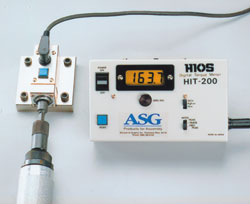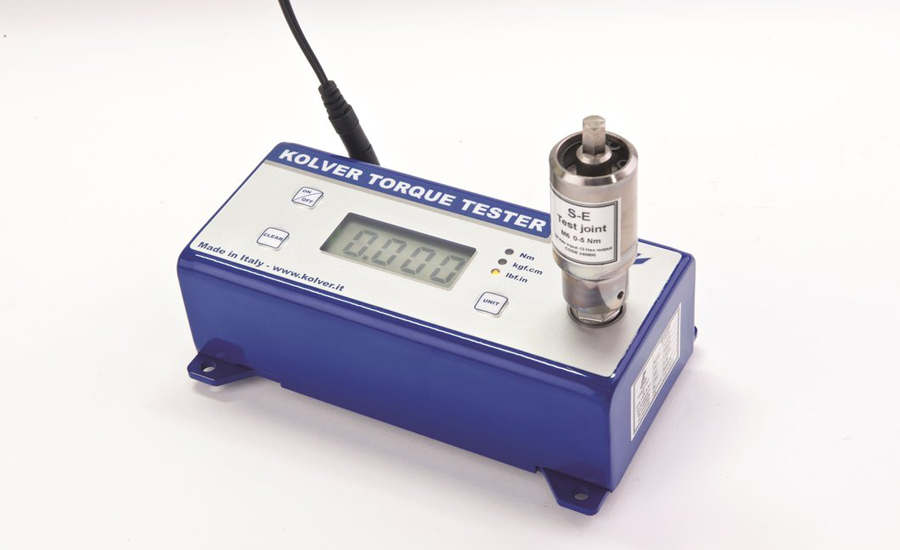How you measure torque can affect your perception of how well your fastening tools perform. This article reviews methods for measuring the torque produced by a tool before, during and after fastening.

Torque measurement has become an integral part of using electric and pneumatic tools to install threaded fasteners. Assemblers routinely test tools for accuracy and repeatability before using them on the line and after making repairs or adjustments. Many assemblers test new tools before buying them.
Assemblers measure torque during fastening to ensure process capability. "In-process" torque monitoring can identify problems with extensions, sockets, methods and access to the joint. It can also indicate when preventive maintenance is needed. Quality engineers perform torque audits on finished products prior to shipping. This is the last chance to catch loose fasteners and short-term relaxation in the joint.
Before Fastening
Every tool manufacturer performs basic capability tests on its tools prior to shipping them. These tests are detailed in ISO 5393, the standard covering power tool testing and certification. To certify the torque accuracy of a tool, the manufacturer must use the tool to run down a fastener 25 times in both hard and soft joints. In a hard joint, the final torque must be reached in an angle of less than 27 degrees after achieving a snug fit. In a soft joint, the final torque must not be reached until an angle of more than 650 degrees has been achieved from a snug fit.
The differences in the torque values obtained with the hard and soft joints, as well as the range of torque values in each case, indicate the accuracy and quality of the tool.
After tools reach the assembly line, their performance should still be checked periodically. Brad Mountz, president and CEO of Mountz Inc. (San Jose, CA), advises assemblers to recalibrate their fastening tools yearly or every 6 months, depending on how much the tools are used. Calibration can be performed in-house, or the tools can be sent to a certified calibration laboratory.

As a backup to regular calibration, assemblers may want to conduct periodic spot checks of the tools using a torque tester with a built-in stationary transducer or a torque analyzer equipped with a rotary transducer. The latter may be more suitable for plants assembling several joint sizes, because one analyzer can work with several sizes of transducer.
"If a tool is out of calibration, you'll find it faster through spot checks than you will in a 6-month or yearly calibration cycle," says Mountz.
Torque-testing equipment can be scattered throughout an assembly line, or it can be gathered in a central location within the plant. Some manufacturers opt to put torque-testing equipment onto a cart so it can be brought to the tools, instead of the other way around.
The accuracy of torque-testing equipment ranges from 0.1 to 1 percent of a given value. In comparison, the clutch of a typical pneumatic tool might be accurate to within 10 to 20 percent. Depending on its sensitivity and features, a torque tester ranges in price from $1,750 to $2,500. A rotary transducer costs between $1,100 and $2,000, and a torque analyzer costs $1,500 to $2,000. A typical assembly plant might invest $500,000 in tools, so in the big picture, that's a small investment.
"The more liability associated with the application, the more money manufacturers are willing to spend on it," adds Mountz. "But, we have a lot of customers in the electronics industry that are just as concerned with controlling torque as the automakers. They just don't want to spend $30,000 for a fastening tool."
Testing a tool before using it on the line will tell engineers if the tool can do the job if all other variables are in control. In a calibration lab or tool crib, engineers can control air pressure and volume, operator influence, fastening rates and joint variations. The tests will show the tool's accuracy, or its ability to hit a target torque. The tests will also reveal the tool's repeatability, or its ability to hit that torque over and over again.
How often to test tools depends on the product and the volume at which it is assembled. Tools can be tested monthly, weekly, daily or at the start of every shift.
"We have customers, such as NASA, that test a tool before using it to fasten anything," Mountz says. "We also have customers that never test their tools. If controlling torque accuracy is an important part of your quality philosophy, we recommend that tools be tested at the start of each day."
Once manufacturers get comfortable with the performance of the tool, they can reduce torque testing. Many manufacturers start out verifying tool performance every seven days, then they back off to a 30- or 90-day process.
Torque testing can give manufacturers a good idea of how well their tools can perform. But, fastening experts warn that such tests don't necessarily show how the tools actually perform on the line. Conditions in the test lab or the tool crib are almost never the same as they are on the shop floor.

During Fastening
Because test labs are different from assembly lines, manufacturing engineers may want to measure dynamic, or "in-process," torque. This is the torque actually applied to the fastener during run-down. Measuring dynamic torque will tell engineers how well the tools are performing on the line. Are the operators consistent? Is the compressor supplying enough air?
DC electric tools have built-in transducers and sophisticated electronics to measure and control dynamic torque. To measure dynamic torque with other types of fastening tools, engineers will need a portable torque analyzer and a rotary transducer. As with tool calibration, how often to measure dynamic torque depends on how critical the joint is.
When evaluating equipment for measuring dynamic torque, engineers should consider its frequency response. In any fastening operation that requires torque measurement, vibration and electrical interference will add to the signal that represents applied torque. These random signals, or "noise," can seriously impair accurate torque measurements. Equipment with a high frequency response can weed out this noise and get a true reading of the torque signal.
Equipment with high frequency response is particularly important for monitoring pulse tools. A pulse tool is powered by a conventional air motor, but it applies torque with a series of hydraulic pulses. Although a torque tester with a frequency response of 300 hertz is adequate for most types of tools, a torque tester with a frequency response of 1,000 hertz should be used with pulse tools.

After Fastening
The need to measure torque doesn't necessarily stop when the assembly is finished. Manufacturers often audit finished assemblies to measure residual torque. This is a measure of the tension that remains in the joint after it has been fastened.
Torque auditing detects loose fasteners and "yielded" fasteners--fasteners that have stretched so much that they no longer provide clamp load. Auditing also detects joint relaxation. In many cases, torque auditing is the final judge of the harmony between the fastening tools, product design and materials, and the assembly process.
Residual torque can be measured using a power tool hooked up to a rotary transducer and torque analyzer. However, residual torque is most often measured using a transducerized electric wrench, a dial wrench or a preset hand tool, such as a click wrench or slip wrench. A click wrench has a calibrated mechanical cam that resists movement until a set torque is reached. A dial wrench has a spring that translates torque into motion on a calibrated dial.
Fastening experts warn that residual torque and dynamic torque are not identical. Residual torque is often lower than dynamic torque. In many cases, the joint relaxes after being fastened. Joint relaxation occurs to some extent in all fastened joints. One part embeds into another. A layer of paint, a spring washer or a soft part, such as an O-ring, compresses under the clamp force.
This relaxation, or creep, is most obvious and dramatic right after force has been applied. In most joints, creep appears within the first 10 to 50 milliseconds. However, some joints can take a long time to settle. Residual torque measured one hour after assembly can differ significantly from residual torque measured a day later. The farther away in time you get from fastening, the less likely it is that the residual and dynamic torque measurements will correspond.
Residual torque can also be higher than dynamic torque. To test a joint after it's been fastened, the operator must overcome friction to start the fastener rotating again in the tightening direction. An accurate reading depends on the operator's ability to stop the moment he sees movement.
Another factor that can influence residual torque is "cross talk." This occurs when torque applied to one fastener affects another fastener in the same assembly. Changing the fastener installation sequence often solves the problem.
Because of these problems, fastening experts advise assemblers to avoid putting much stock in differences between dynamic and residual torque measurements. Measuring residual torque won't tell you what caused the problem, only that there might be one. It also can't tell you how good the fastening tool is.
Indeed, assemblers may not want to measure residual torque at all, especially if the joint was fastened with a DC-electric tool. Since the fastener is already in the elastic zone, measuring residual torque could actually destroy the joint.
What's more, too many variables can affect residual torque measurements. For example, an operator with average strength might get a different result than a former football player. If a click wrench is calibrated for 20 newton-meters, and you click it once, it should be 20 newton-meters. If you click it again, is it still 20 newton-meters? Probably not.
The Big Picture
Which torque measurement method to use depends on the product and the manufacturer. For mission-critical fasteners, such as the lug nuts on a car, an assembler might use all three methods. On the other hand, an assembler installing three screws in a $2 plastic candy dispenser might not measure torque at all.
If torque measurement is necessary, the design engineer should specify how torque should be measured. Designers may give you a torque value, but they rarely say whether it should be measured statically or dynamically. That makes a big difference.

